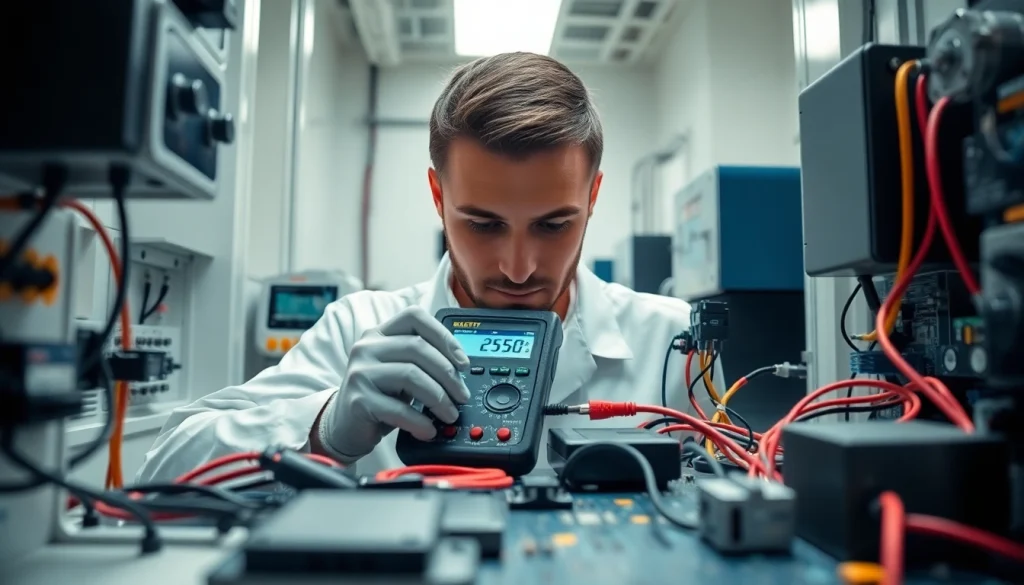Comprehensive Guide to Electrical Testing: Methods, Benefits, and Best Practices

Understanding Electrical Testing
What is Electrical Testing?
Electrical testing is a systematic process used to evaluate the functionality and performance of electrical components, systems, and equipment. This type of testing can involve measuring various parameters such as voltage, current, and resistance to ensure that all electrical systems operate within their specified limits. Electrical testing encompasses a variety of procedures designed to verify the integrity, safety, and reliability of electrical installations. Common assessments include checking for continuity, insulation resistance, and grounding integrity. Each of these tests plays a key role in preventing failures and enhancing the operational lifespan of equipment.
Importance of Electrical Testing
Electrical testing is crucial for several reasons. First and foremost, it ensures the safety of both personnel and equipment. By identifying potential faults and failures before they escalate into major issues, electrical testing mitigates risks associated with electric shocks, fires, and equipment damage. Moreover, regular testing allows organizations to remain compliant with safety standards and regulations, thereby avoiding costly penalties and liabilities. In an industrial setting, routine electrical assessments can lead to improved energy efficiency and performance, ultimately increasing productivity and reducing operational costs.
Overview of Electrical Testing Standards
Several regulatory bodies have established standards for electrical testing to ensure consistency, safety, and compliance across industries. The National Fire Protection Association (NFPA) and the Institute of Electrical and Electronics Engineers (IEEE) provide guidelines that manufacturers and technicians must follow. For example, ASTM International offers testing standards for the electrical properties of materials. Understanding these standards is essential for anyone involved in electrical works, as adherence not only guarantees operational efficiency but also protects human life and property.
Types of Electrical Testing Methods
Continuous Current Testing
Continuous current testing is a fundamental method used to assess the functionality of electrical circuits. This test involves applying a sustained electrical current to a circuit or component and monitoring its behavior over time. By evaluating parameters such as voltage drop, resistance, and heat generation, technicians can determine whether a particular component is functioning correctly or if there are underlying issues that must be addressed. Continuous current testing is particularly essential for maintaining the integrity of power distribution systems and ensuring reliable operation in industrial settings.
Insulation Resistance Testing
Insulation resistance testing is a critical procedure that evaluates the effectiveness of insulation materials in electrical systems. This test typically involves applying a high voltage to a conductor and measuring the resistance between that conductor and ground or other conductors. High insulation resistance values indicate good quality insulation material; low resistance values may signal deterioration or damage, which could lead to shorts or insulation failure. Performing insulation resistance tests is crucial, particularly in prevention strategies for electrical faults, which can pose significant hazards.
Ground Fault Testing
Ground fault testing assesses the ability of a circuit to detect and respond to electrical faults that may occur due to grounding issues. This testing is essential for circuits equipped with ground fault circuit interrupters (GFCIs), as these devices are designed to protect against electric shocks by cutting off power when they detect faults. Ground fault testing involves simulating a fault condition to verify the effectiveness and speed of the GFCI activation. Regular testing assures that systems continue to provide the necessary protection against electrical hazards, thus enhancing safety in residential and commercial environments.
Benefits of Regular Electrical Testing
Enhancing Safety Standards
The primary advantage of regular electrical testing is the enhancement of safety standards within a facility. By conducting periodic assessments, organizations can quickly identify and rectify potential hazards, thereby reducing the risk of electrical accidents. Regular testing ensures that safety devices, such as circuit breakers and fuses, function as intended and provides peace of mind for both employees and management. Moreover, compliance with safety regulations is vital for operational legitimacy and can lead to favorable insurance premiums and lower liability risks.
Improving Equipment Reliability
Regular electrical testing not only mitigates risks but also improves the reliability of electrical equipment. By identifying faults and scheduling timely repairs, businesses can prevent unexpected downtimes that might disrupt operations. Testing allows for the optimization of maintenance schedules based on actual equipment conditions rather than arbitrary timeframes. This proactive approach to equipment management results in improved performance, longer equipment life, and continuous operational efficiency.
Complying with Regulations
Compliance with local, national, and international electrical safety standards is non-negotiable for every organization. Regular electrical testing is often a legal requirement intended to ensure that companies adhere to safety protocols. Failing an inspection can lead to business shutdowns, expensive fines, and severe reputational damage. By establishing a routine electrical testing schedule, organizations place themselves in a robust compliance position, demonstrating their commitment to upholding safety and reliability standards.
Best Practices for Conducting Electrical Testing
Preparation and Equipment Needed
Preparation is essential in conducting effective electrical testing. Technicians must gather the necessary tools and equipment, including multimeters, insulation testers, clamp meters, and specialized test sets consistent with the testing being performed. Additionally, it is vital to familiarize oneself with the relevant safety protocols and regulatory standards applicable to electrical testing procedures. Ensuring that equipment is calibrated and functioning correctly is also a key step before commencing any tests, as faulty testing equipment can yield misleading results.
Step-by-Step Testing Procedures
Implementing a clear step-by-step approach is crucial for effective electrical testing. Typically, the process begins with isolating the circuit from the electrical supply to prevent accidents. Following isolation, technicians will conduct preliminary checks to confirm that the testing environment is safe. Each test will then be performed according to standardized procedures—such as continuous current testing, insulation resistance testing, and ground fault testing—documenting all observations and measurements meticulously. Detailed records greatly assist in future testing, maintenance, and compliance audits.
Post-Testing Analysis
Post-testing analysis is a critical phase in the electrical testing process. After conducting the tests, technicians should analyze the gathered data to detect anomalies or trends that require attention. This may involve comparing results against previous measurements or standard benchmarks to determine if any components fall below acceptable performance levels. If issues are identified, a recommendation for corrective actions should be made to ensure compliance and reliability. Educating the operational team about observed testing results and preventive measures is also a key facet of this analysis.
Future Trends in Electrical Testing
Advancements in Testing Technology
The field of electrical testing is continuously evolving with advancements in technology. Modern testing equipment now incorporates digital displays, automated systems, and smart technology, allowing for more accurate and comprehensive data collection. Furthermore, innovations such as thermal imaging and predictive maintenance tools enable technicians to detect issues that traditional methods may overlook. These advancements not only enhance testing efficiency but also extend the capabilities of electrical testing to highlight preventive maintenance needs proactively.
Emerging Standards and Regulations
The landscape of electrical testing is also shaped by emerging standards and regulations. As new technologies and practices develop, standards organizations strive to keep pace by updating guidelines that govern electrical performance, safety, and testing protocols. Organizations that remain informed about these changes can benefit from improved safety, enhanced equipment performance, and increased compliance. Awareness of upcoming regulations is essential for all professionals involved in electrical testing, ensuring they are prepared to meet evolving demands.
Impact of IoT on Electrical Testing
As the Internet of Things (IoT) continues to permeate industries, its impact on electrical testing will grow significantly. IoT-enabled devices can provide real-time data from electrical systems, allowing for continuous monitoring and immediate alerts when performance issues arise. This real-time capability enhances the reliability of electrical systems, reduces the need for manual inspections, and facilitates compliance monitoring. Furthermore, data analytics tools can offer insights that help organizations plan for maintenance based on actual usage patterns rather than estimated schedules, providing more cost-effective and proactive operational strategies.







